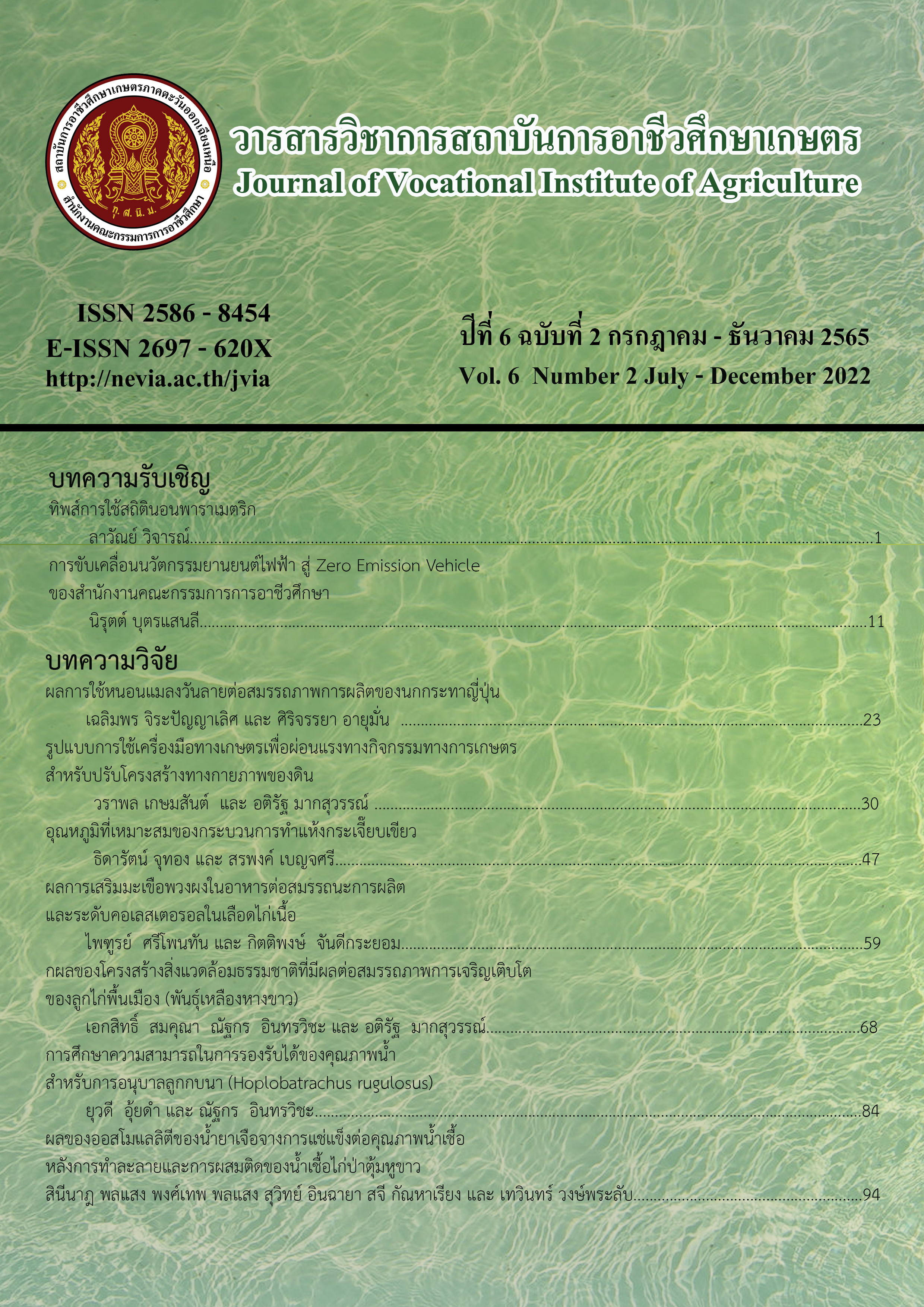The Carrying Capacity Study of Water Quality for the Nursing of Tadpoles (Hoplobatrachus rugulosus)
Main Article Content
Abstract
The objective of this study was to study of carrying capacity of water quality for nursing of tadpoles (Hoplobatrachus rugulosus). The methodology of this study was divided into 3 steps; 1) studying secondary data involving nursing of tadpoles 2) nursing 10 tadpoles, 20-day- old, for 30 days using non drainage water and 3) comparing water qualities of this research with the secondary data. The results showed that pH of the water was from 7.20 to 7.80, water temperature was from 25.18 to 28.30, alkalinity was from 8.30 to 632.92 mg/l, dissolved oxygen was from 0.00 to 4.90 mg/l, dissolved ammonia was from 0.05 to 934.00 mg/l, turbidity was from 26.08 to 434.67 NTU, the average tadpoles’ length was 5.18 centimeters, the average tadpoles’ weight was 16.38 grams and the tadpoles’survival rate was 90%.
Article Details

This work is licensed under a Creative Commons Attribution-NonCommercial-NoDerivatives 4.0 International License.
The content and information in articles published in the Journal of Vocational Education in Agriculture are the opinions and responsibility of the article's author. The journal editors do not need to agree or share any responsibility.
Articles, information, content, etc. that are published in the Journal of Vocational Education in Agriculture are copyrighted by the Journal of Vocational Education in Agriculture. If any person or organization wishes to publish all or any part of it or to do anything. Only prior written permission from the Journal of Vocational Education in Agriculture is required.
References
กรรณิการ์ กาญจนชาตรี และวุฒิชัย เจนการ. (2540). ศึกษาการผสมพันธุ์กบ อาหารกบระยะต่างๆ และเทคนิคการให้อาหาร. วารสารการประมง, 50(1), 11-19.
Dani, N. P., et al. (1996). Proximate composition and nutritive value of leg meat of two edible spicies of frogs, Rana hexadactyla and R. tigerina. Journal of Food Science and Technology, 3(2), 109-110.
ทาริกา โกฏสันเทียะ. (2553). ผลของการใช้สมุนไพรชนิดต่างๆร่วมกับน้ำสกัดชีวภาพในการยับยั้งการเกิดโรคในลูกอ๊อดกบ. วารสารมหาวิทยาลัยราชภัฎสกลนคร, 2(3), 158-165.
อนุวัติ อุปนันชัย และคณะ. (2551). การใช้ยีสต์เพื่อเพิ่มประสิทธิภาพของอาหารกบนา. ใน การประชุมวิชาการประมงประจำปี 2551 (น. 157-172). กรุงเทพฯ: กรมประมง.
สุชาติ จุลอดุง และคณะ. (2552). ผลของฮอร์โมน 17β-estradiol ต่อการแปลงเพศกบนาให้เป็นเพศเมีย. (รายงานผลการวิจัย). กรุงเทพฯ: กรมประมง.
จตุรงค์ คงแก้ว และคณะ. (2556). ขีดความสามารถในการรองรับและมาตรการการจัดการท่องเที่ยวแนวปะการังน้ำตื้นเกาะไข่นอก จังหวัดพังงา. วารสารสิ่งแวดล้อมและทรัพยากรธรรมชาติ, 11(1), 70-87.
หิรัญ หิรัญรัตรพงศ์ และคณะ. (2560). การประเมินขีดความสามารถในการรองรับนักท่องเที่ยวของอุทยานแห่งชาติเขาคิชฌกูฏ (ส่วนรอยพระพุทธบาทพลวง). วารสารวิทยาศาสตร์บูรพา, 22(3), 557-568.
ยงยุทธ ปรีดาลัมพะบุตร. (2539). การประเมิน Carrying Capacity ของพื้นที่แหล่งเลี้ยงกุ้งคลองปานาเระ อำเภอยะหริ่ง จังหวัดปัตตานี. (รายงานผลการวิจัย). กรุงเทพฯ: กรมประมง.
อนุวัติ อุปนันไชย และคณะ. (2560). อุณหภูมิที่เหมาะสมในการอนุบาลลูกอ๊อดเพื่อผลิตกบนาเพศเมีย. วารสารวิจัยและส่งเสริมวิชาการเกษตร, 34(3), 31-40.
อนุวัติ อุปนันไชย และพัชรี สิงห์สม. (2547). การอนุบาลลูกอ๊อดกบนาด้วยอัตราความหนาแน่นที่แตกต่างกัน. (รายงานผลการวิจัย). กรุงเทพฯ: กรมประมง.
อนุวัติ อุปนันไชย และคณะ. (2549). ความถี่ในการให้อาหารต่อการเจริญเติบโตของกบนาระยะวัยอ่อน. (รายงานผลการวิจัย). กรุงเทพฯ: กรมประมง.

